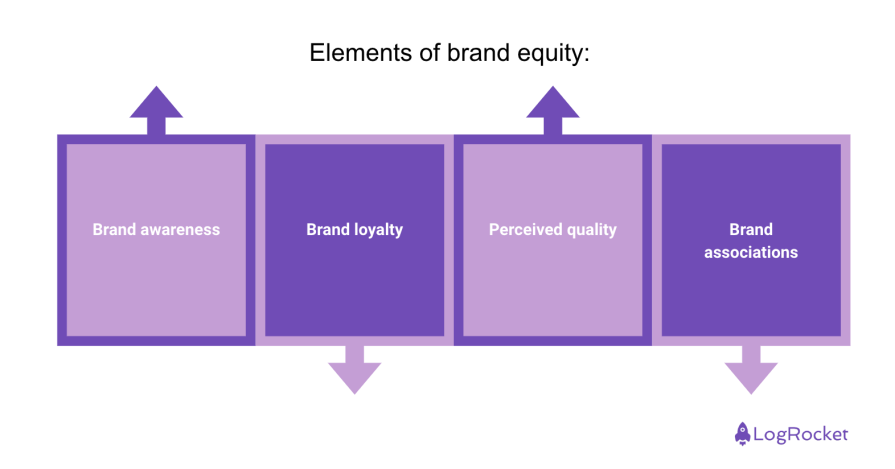Picture this… you’re navigating a marketplace, surrounded by a wide range of competing products vying for your attention. You see a product that you recognize, you can relate to, and are instantly drawn towards it.

Why is this? What’s this concept and how can you leverage it to grow your business? More importantly, how can you ensure that your brand isn’t just relevant, but is loved and cherished by customers over time?
It all comes down to building out your brand equity. In this article, you’ll learn what brand equity is, the different elements that go into it, and the challenges that might arise while you pursue it.
Brand equity refers to the intangible value that a brand holds in the minds of its customers. It encompasses various elements such as brand awareness, brand loyalty, perceived product/service quality, and even brand associations. You can also think of brand equity as reflecting the trust, emotional connection, and reputation that customers have with the brand.
Customer value isn’t solely based on tangible product/service features, it’s built over time through positive customer experiences, consistent messaging, and effective marketing efforts. A brand with strong brand equity will command customer loyalty and trust, which can eventually turn into premium pricing in the marketplace.
As a PM, you can cultivate strong brand equity that drives customer preference and loyalty. Listed below are the four elements that work together to shape the overarching narrative of a brand, defining its essence, value proposition, and competitive position in the marketplace:

For customers to buy your products/services, they must first know your brand. Brand awareness is all about making sure that when potential customers think of a product/service within a category, your brand is the first one that springs to mind. They should be able to identify your brand through the name, logo, tagline, or even just the colors associated with the brand.
The more aware customers are about your brand, the more likely they are to consider your products/services when making purchasing decisions. Brand awareness lays the groundwork for strong brand recall and recognition, paving the way for deeper customer connections and trust.
You achieve brand loyalty when customers keep coming back to buy more product/service offerings, time and time again. Brand loyalty isn’t just about making repeat sales transactions, it’s about fostering strong customer relationships built on positive brand experiences, emotional connection, trust, and satisfaction.
When customers develop a strong affinity for your brand, they become loyal advocates, spreading positive word-of-mouth referrals and defending the brand organically against competitors. Brand loyalty not only ensures consistent revenue streams but also serves as a potential barrier to entry for newcomers in the market.
The quality of your products/services isn’t just about what’s being offered, it’s also about how they are perceived by your target audience. Think of it as the aura of excellence that surrounds your brand and the difference between being merely good and being exceptional in the minds of potential customers. It influences the customers’ judgment about the value being created and differentiating it from competitors.
You can achieve positive perceived quality by consistently delivering on your brand promise(s), exceeding customer expectations, and maintaining high standards. Perceived quality also helps justify premium pricing in the marketplace.
The layers of meaning and symbolism that customers attach to your brand are brand associations. These can be formed through a variety of touchpoints — advertising, product placements, endorsements, and cultural connections. They evoke certain emotions, shape customer perceptions, and give life to your brand with a distinct identity and personality, making it memorable in the minds of potential customers.
A strong brand identity, coupled with relentless innovation, customer-centricity, and strategic expansion, can elevate your brand and establish enduring brand equity in competitive marketplaces. Several brands stand out for exceptionally high brand equity.
If you’re looking for a brand with sky-high brand equity in the tech world, it’s Apple. What sets the brand apart from its competitors is its unwavering commitment to innovation, design excellence, and seamless user experience. Apple’s elegant products evoke a sense of quality, reliability, luxury and exclusivity, a global status symbol, through its iconic simplicity of product design and smooth integration of hardware and software.
When you think of beautifully made animated movies, Disney instantly comes to mind. The company is synonymous with storytelling magic and entertainment excellence, encompassing a vast empire of beloved characters, movies, theme parks, and merchandise.
Disney’s brand equity thrives on its ability to create immersive experiences that captivate audiences of all ages, leveraging its commitment to quality, creativity, and wholesome family values.
As one of the pioneers of the personal computing revolution, Microsoft’s brand is built on a foundation of reliability, productivity, and enterprise-grade solutions. The company differentiates itself through its ability to adapt and evolve with the times, embracing new technologies while staying true to its core values of innovation and accessibility. The brand’s reputation for stability and security has earned the trust of businesses and users alike.
You can build brand equity by creating positive brand associations, fostering loyalty, and delivering exceptional customer experiences. When these are implemented consistently and authentically, your brand can earn trust from your customers while solidifying your business in the marketplace:

Clearly define your brand’s unique value proposition and position it effectively in the marketplace. It helps to differentiate your brand from competitors and build strong brand equity with your customers. This strategy requires a thorough understanding of your target audience, identifying competitive advantages, and communicating the brand’s value through storytelling and marketing activities.
Building emotional connections with your target audience can significantly impact your brand equity. By tapping into certain emotions like joy, nostalgia, empowerment, aspiration, etc., you can create memorable experiences that resonate with your customers on a deeper level. This can be achieved through cause-related marketing, authentic brand narratives, and community-building initiatives.
Establishing a cohesive brand identity across all touchpoints, both digital and physical, is crucial for building strong brand equity. Consistency helps potential customers develop familiarity with the brand and reinforces brand recognition, making it easier for them to connect with and remember the brand over time. Maintain consistent brand messaging and imagery, also make it unique and memorable.
Provide exceptional customer experiences with every brand interaction. This includes understanding your customers’ needs, addressing their pain points, and delivering solutions that exceed their expectations. Whether it’s through responsive customer service, intuitive user interfaces, or personalized interactions, prioritizing customer satisfaction will foster brand loyalty and positive word-of-mouth referrals.
Innovative development
Leverage industry trends, incorporate customer feedback for product enhancements, and invest in user research to introduce new offerings that can address evolving customer needs. Monitor competitor initiatives and differentiate your offerings.
Assessing and quantifying brand equity includes a combination of both qualitative and quantitative methods to measure various aspects of brand performance, customer perception, and financial value. This’ll give you a holistic understanding of your brand equity, identify the areas for improvement, and develop specific strategies to enhance your brand’s equity, relevance, and value in the marketplace.
There are various channels through which you can reach out to your customers and get valuable insights into how strong your brand equity is. Some of these include:
Combined with qualitative methods, you also want to have quantitative insights that can help you make data-driven product and marketing decisions. Some of these include:
Maintaining strong brand equity is a continual effort that involves overcoming various challenges to preserve the brand’s value, relevance, and competitive advantage in the minds of your customers. By addressing these challenges proactively and strategically, you can effectively maintain and strengthen your brand equity, securing your brand’s position as a market leader and driving long-term business success.
The needs, preferences, behaviors of customers are constantly evolving, due to factors like social trends, cultural shifts, and technological advancements. Your brand must adapt to these changes by staying attuned to customer demands and their expectations. Perceived value should still be prominent enough for your customers to continue purchasing your product/service offerings.
Controversies, scandals, crises or any other negative publicity can permanently tarnish your brand’s reputation and erode customer trust. You must be able to manage these issues effectively through positive PR and proactively address them to mitigate reputational damage. Mistakes do happen. Accept and apologize to customers when you’re in the wrong.
As your brand expands into new markets, product categories, or distribution channels, there is a risk of diluting your brand equity by stretching your brand too thin and/or comprising your core values and brand identity. Maintaining brand integrity and cohesiveness across all brand extensions is crucial to preserving your brand equity. Ensure your marketing efforts are formed around comprehensive brand equity strategies.
Market fluctuations, economic downturns, and geopolitical uncertainties can impact customer spending patterns and industry dynamics of supply and demand. This affects brand performance and resilience. You can navigate these changes by staying agile, adaptive, and proactively responding to changing market conditions.
Ensuring consistent branding and messaging across all customer touchpoints can be challenging, especially if your brand is expanding into new markets or channels. Inconsistencies in branding, communication, and customer experiences can dilute your brand equity and reduce customer loyalty. Ensure that your core brand values are resonated through all branding and marketing efforts, and across all your product/service offerings.
Brand equity is a strategic asset that fuels marketing strategies, cultivates customer loyalty, drives long-term business growth, and shapes product development efforts. By prioritizing brand equity as a key driver of success, you can build enduring relationships with your customers, differentiate your product/service offerings in the competitive marketplace, and achieve sustainable profitability over time.
A strong brand equity is the culmination of years of investment in building a branding identity, delivering exceptional products/services, and fostering meaningful connections with your customers. Brands that are unique, memorable, and relatable are often those that achieve strong brand equity. What does your brand mean and how do you want your brand to be perceived by your customers?
Featured image source: IconScout

LogRocket identifies friction points in the user experience so you can make informed decisions about product and design changes that must happen to hit your goals.
With LogRocket, you can understand the scope of the issues affecting your product and prioritize the changes that need to be made. LogRocket simplifies workflows by allowing Engineering, Product, UX, and Design teams to work from the same data as you, eliminating any confusion about what needs to be done.
Get your teams on the same page — try LogRocket today.

Most teams fail at autonomy. Learn how clear rules help product teams move faster without micromanagement.

A practical framework for PMs to use AI in ideation without sacrificing judgment, strategy, or decision quality.

A practical five minute revenue estimation method to help product managers compare ideas, drop low impact features, and prioritize smarter.

A practical guide for PMs who want to stop being bottlenecks, delegate smarter, and lead teams effectively with a clear ownership framework.